Which option is enabled with the NKP Pro licensing tier?
An organization is setting up a new set of NKP clusters for R&D. The R&D director requires full admin access for the team on infrastructure dedicated to R&D.
What is the proper method for the engineer to ensure these objectives are met?
A company is required by NIST to follow FIPS guidelines for compliance.
What is the first step for enabling FIPS in NKP?

A Platform Engineer is trying to create a new NKP cluster and is getting the error shown in the exhibit.
What is the most likely cause of this error?
A Kubernetes administrator needs to deploy a new Kubernetes cluster into a new workspace. This cluster requires a predictive analytics solution that detects current and future anomalies. Which option does the administrator need to deploy after the cluster is ready?
A Platform Engineer is attaching existing Kubernetes clusters to NKP, but a particular Kubernetes Amazon EKS cluster is getting errors with application deployments. These errors are related to persistent volumes. What could be the issue, and what can the engineer do?
Which NKP-supported infrastructure will not receive CAPI components when an NKP cluster is deployed to it?
The bastion host is currently set up with Rocky Linux and the engineer will need to configure it to meet the requirements for the air-gapped cluster.
Which first step should the engineer take to configure the bastion host?
A Platform Engineer is deploying an NKP workload cluster using the nkp create cluster vsphere command. The cluster will be utilized by the company’s code-green team and the engineer has already created a code-green NKP workspace on the NKP management cluster.
After issuing the deploy command, the engineer monitored the build using the nkp describe cluster command and confirmed it completed successfully. However, a few hours later, after logging into the NKP UI, the engineer checked the code-green NKP workspace and saw that the NKP workload cluster was not there.
What is the likely reason the NKP workload cluster is not in the code-green NKP workspace?
A company has been modernizing on cloud-native platforms for the past few years and has been running some small consumer support utilities on their production NKP cluster. After a thorough testing and QA cycle with simulated workloads on a development cluster, the company is ready to bring their online retail application into the fold. While they have sufficient system resources to scale the NKP cluster properly from a performance standpoint, they also want to ensure they properly scale their monitoring stack’s resource settings to retain a sufficient amount of data to see how overall system resource utilization trends for the NKP cluster over several months’ time with the added workloads. Which NKP Platform Application component should the company be most concerned with adjusting, and how should their Platform Engineer adjust it?
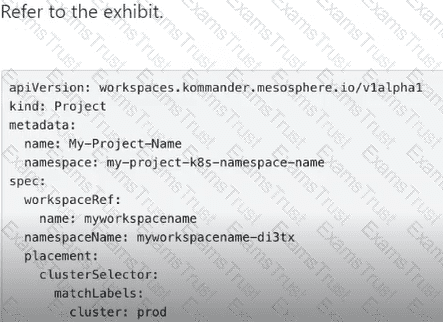
After creating the project, what should the administrator configure in order for the new software releases to automatically deploy to both environments?
NKP cluster nodes require a disk for some of its deployed components, outside of an application’s persistent volume requirements. What are these components and where are they deployed?
An infrastructure team has configured a Backup Storage Location on an existing AWS bucket and created a backup named testbackup. What command can the team use to view the backup?
At a national defense company, protecting sensitive data is their top priority. With the increase in cyber-attacks, they have decided to implement an air-gapped Kubernetes environment to manage their critical applications, ensuring that no information could leak to the outside. The Kubernetes environment has three clusters deployed for their applications with centralized management. What type of licensing is required to enable this environment?

The cluster arca will host a new application that needs to add more workers. The company cannot get more NKP licenses, so it has decided to delete the demo cluster and add the required workers to the arca cluster. How should the engineer delete the demo cluster from this UI?
A company was using a test application called temp-shop developed in the temp-ecommerce NKP Starter cluster. Now, the cluster has just been taking up valuable resources that could be used for other projects, so the development team has decided to remove it.
Before proceeding, they verified that they had the cluster configuration file temp-ecommerce.conf.
What command should the development team execute to delete the cluster with its nodes and application?
Prior to implementing NKP, a company had created a number of Kubernetes (K8s) clusters using kubeadm. While they are deploying new managed clusters via NKP, the company does not wish to migrate workloads from these pre-existing native K8s clusters over to new NKP clusters just yet.
What are the requirements to have these clusters attached to their NKP management cluster?
A development team is working on a new application that requires access to certain cluster resources. The team needs to ensure that they have limited permissions to avoid unauthorized changes in other environments. Among the tasks they will perform are the following:
Deploy new versions of the application to their specific namespace.
Scale deployments according to demand.
View logs and metrics of their applications to monitor performance.When using the NKP GUI, what type of access should the team configure?

A DevOps team faces a growing challenge of managing logs from multiple applications in an NKP cluster. With several teams working on different projects, it is essential to implement a Multi-Tenant Logging system that allows each team to access their own logs securely and efficiently. Initially, two namespaces have been configured for each project, as shown in the exhibit. Then a ConfigMap has also been configured for each tenant, which contains the logging configuration. Which YAML output corresponds to a retention period of 30 days for tenant-innovation and seven days for tenant-analytics?
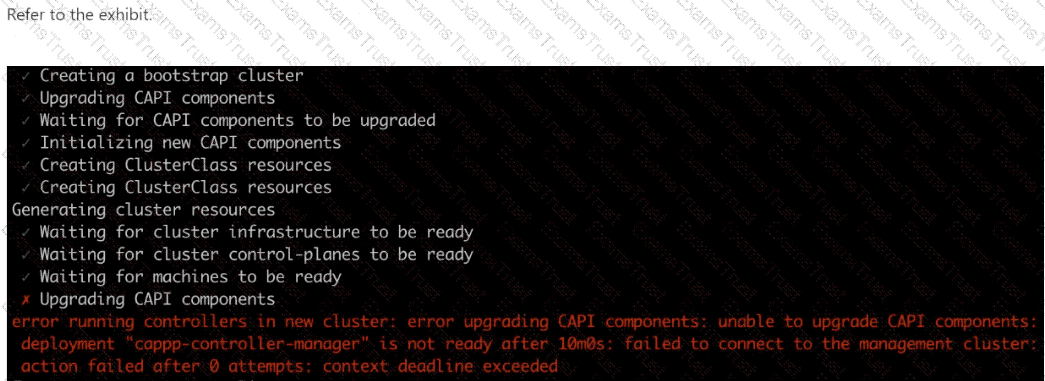
An administrator is provisioning an NKP cluster. After the VM creation task, the error shown in the exhibit is produced.
What could be the reason?
A Platform Engineer needs to create an NKP custom image for vSphere.
Which option should the engineer use?
A Platform Engineer needs to do an air-gapped installation of NKP. This environment needs to run without Internet access and be fully operational, including updates. Docker has been installed, and the NKP bundle exists on a bastion host. What is the first command that the engineer must run to begin the process?
A Platform Engineer is deploying a new NKP cluster that has internet connectivity. Now, a Cloud Administrator and Security Administrator are discussing the security of communications between the NKP Kubernetes cluster and the container registry. The engineer proposes to have an on-prem private registry.
What is the most significant reason that the engineer should create a private registry instead of configuring a secure connection between the NKP cluster and Github (SaaS)?
When deploying NKP using the Nutanix provisioning method (CAPX), what are the supported OS platforms?
A Platform Engineer is attempting to delete an attached cluster from the NKP UI, but it is stuck in a 'deleting' state and does not get removed. How can the engineer resolve this attempt to detach the cluster so that it is removed from the UI and no longer managed by NKP?
A company has a new DevOps team that needs to be provided cloud native computing resources. This team will need to have access to multiple NKP clusters for development, testing and validation of an in-house application. However, they also need to be restricted to a specific namespace and a consistent level of access across the clusters within this namespace so that they do not adversely impact the environment of other user groups or the clusters themselves.
As a part of this consideration, the new team also needs to be limited to the amount of storage, CPU and memory they can consume on the clusters. A Platform Engineer has been tasked with providing the appropriate level of access to the team on these multiple NKP clusters.
How should the engineer best accomplish this task?
A Platform Engineer has been tasked with setting up a secure and isolated environment for managing an NKP environment. The environment will have no access to the Internet but will be required to create additional NKP clusters in the future. The security team has recommended using a bastion host to achieve this goal. What is the primary purpose of a bastion host in this scenario?
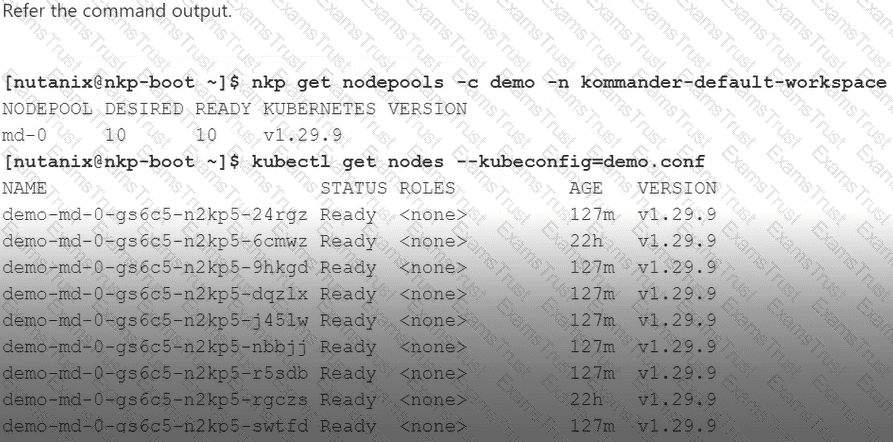
The Platform Engineer needs to expand an NKP Pro demo cluster due to workload capacity constraints. The demo cluster has 150 vCPUs available to it from a licensing standpoint. Each worker node has 8 vCPUs and each control plane node has 4 vCPUs.
Which two options are valid for expanding the demo cluster and remaining compliant with licensing? (Choose two.)
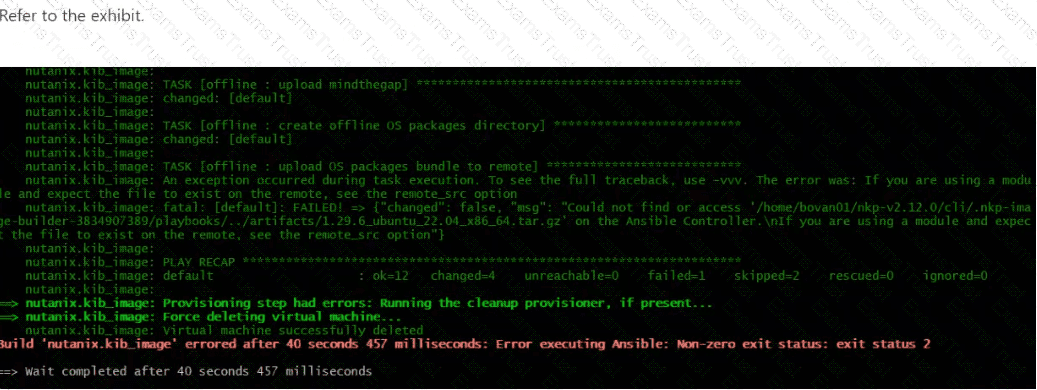
A Platform Engineer is preparing to deploy a new NKP cluster on Nutanix infrastructure into an air-gapped environment. As part of the preparation process, the engineer is supplying a Ubuntu 22.04 instance to be used for NKP cluster nodes that conforms to the corporate OS image hardening standards. However, during the NIB preparation process, the error shown in the exhibit is received.
What is the likely reason the NIB preparation attempt has failed?
A Platform Engineer works for a service provider and needs to establish access and authentication for multiple clients into an NKP cluster. Each client has their own LDAP source that should be used for authentication into the cluster.
How would this be accomplished?
A Platform Engineer manages an NKP environment and is preparing a machine image to become an NKP cluster node. Which statement is correct regarding the default node preparation process?
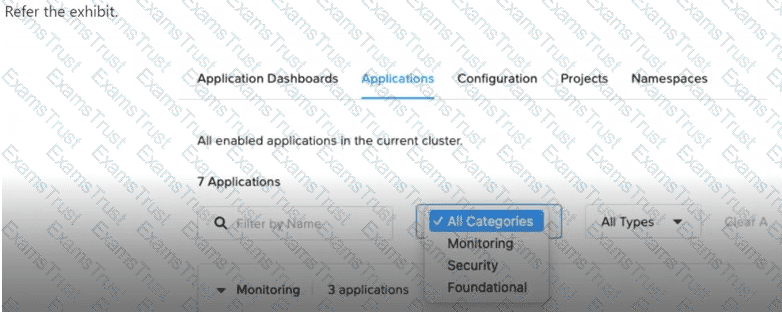
After selecting the Production workspace and selecting View Details for the cluster prod-01, a Platform Engineer wanted to enable the NKP Insights application. This application is under the Observability category, but this category doesn’t appear in the list.
Which action should the engineer take to be able to deploy the NKP Insights application in the Kubernetes cluster for this workspace?